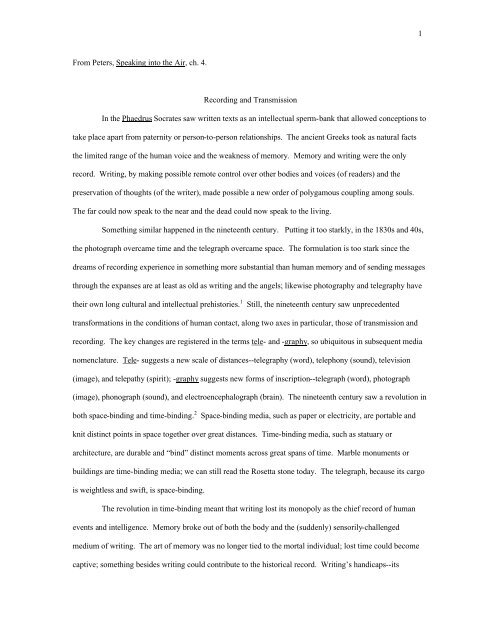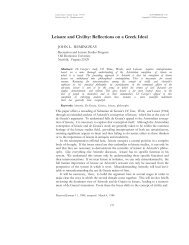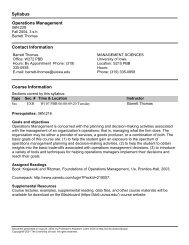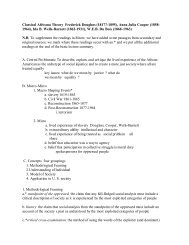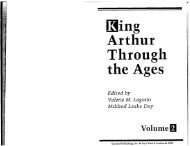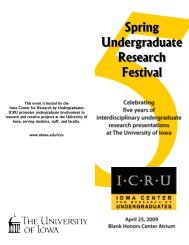1 From Peters, Speaking into the Air, ch. 4 ... - University of Iowa
1 From Peters, Speaking into the Air, ch. 4 ... - University of Iowa
1 From Peters, Speaking into the Air, ch. 4 ... - University of Iowa
You also want an ePaper? Increase the reach of your titles
YUMPU automatically turns print PDFs into web optimized ePapers that Google loves.
1<br />
<strong>From</strong> <strong>Peters</strong>, <strong>Speaking</strong> <strong>into</strong> <strong>the</strong> <strong>Air</strong>, <strong>ch</strong>. 4.<br />
Recording and Transmission<br />
In <strong>the</strong> Phaedrus Socrates saw written texts as an intellectual sperm-bank that allowed conceptions to<br />
take place apart from paternity or person-to-person relationships. The ancient Greeks took as natural facts<br />
<strong>the</strong> limited range <strong>of</strong> <strong>the</strong> human voice and <strong>the</strong> weakness <strong>of</strong> memory. Memory and writing were <strong>the</strong> only<br />
record. Writing, by making possible remote control over o<strong>the</strong>r bodies and voices (<strong>of</strong> readers) and <strong>the</strong><br />
preservation <strong>of</strong> thoughts (<strong>of</strong> <strong>the</strong> writer), made possible a new order <strong>of</strong> polygamous coupling among souls.<br />
The far could now speak to <strong>the</strong> near and <strong>the</strong> dead could now speak to <strong>the</strong> living.<br />
Something similar happened in <strong>the</strong> nineteenth century. Putting it too starkly, in <strong>the</strong> 1830s and 40s,<br />
<strong>the</strong> photograph overcame time and <strong>the</strong> telegraph overcame space. The formulation is too stark since <strong>the</strong><br />
dreams <strong>of</strong> recording experience in something more substantial than human memory and <strong>of</strong> sending messages<br />
through <strong>the</strong> expanses are at least as old as writing and <strong>the</strong> angels; likewise photography and telegraphy have<br />
<strong>the</strong>ir own long cultural and intellectual prehistories. 1 Still, <strong>the</strong> nineteenth century saw unprecedented<br />
transformations in <strong>the</strong> conditions <strong>of</strong> human contact, along two axes in particular, those <strong>of</strong> transmission and<br />
recording. The key <strong>ch</strong>anges are registered in <strong>the</strong> terms tele- and -graphy, so ubiquitous in subsequent media<br />
nomenclature. Tele- suggests a new scale <strong>of</strong> distances--telegraphy (word), telephony (sound), television<br />
(image), and telepathy (spirit); -graphy suggests new forms <strong>of</strong> inscription--telegraph (word), photograph<br />
(image), phonograph (sound), and electroencephalograph (brain). The nineteenth century saw a revolution in<br />
both space-binding and time-binding. 2 Space-binding media, su<strong>ch</strong> as paper or electricity, are portable and<br />
knit distinct points in space toge<strong>the</strong>r over great distances. Time-binding media, su<strong>ch</strong> as statuary or<br />
ar<strong>ch</strong>itecture, are durable and “bind” distinct moments across great spans <strong>of</strong> time. Marble monuments or<br />
buildings are time-binding media; we can still read <strong>the</strong> Rosetta stone today. The telegraph, because its cargo<br />
is weightless and swift, is space-binding.<br />
The revolution in time-binding meant that writing lost its monopoly as <strong>the</strong> <strong>ch</strong>ief record <strong>of</strong> human<br />
events and intelligence. Memory broke out <strong>of</strong> both <strong>the</strong> body and <strong>the</strong> (suddenly) sensorily-<strong>ch</strong>allenged<br />
medium <strong>of</strong> writing. The art <strong>of</strong> memory was no longer tied to <strong>the</strong> mortal individual; lost time could become<br />
captive; something besides writing could contribute to <strong>the</strong> historical record. Writing’s handicaps--its
2<br />
blindness and deafness--were suddenly revealed. Scenes, and more importantly, events, could now be caught<br />
without <strong>the</strong> intervention <strong>of</strong> word, pencil, or paintbrush, thanks to <strong>the</strong> camera. More strikingly yet, <strong>the</strong><br />
epitome <strong>of</strong> transience--<strong>the</strong> flow <strong>of</strong> time itself--could now be transcribed in images and sounds by film or<br />
phonograph. By preserving people’s apparitions in sight and sound, media <strong>of</strong> recording helped repopulate<br />
<strong>the</strong> spirit-world. Every new medium is a ma<strong>ch</strong>ine for <strong>the</strong> production <strong>of</strong> ghosts. As Friedri<strong>ch</strong> Kittler argues,<br />
“The spirit-world is as large as <strong>the</strong> storage and transmission possibilities <strong>of</strong> a civilization.” The oldest<br />
available print <strong>of</strong> a printing press is a 1499 image showing skeletons cavorting about a press, pages in hand,<br />
doing a dance <strong>of</strong> <strong>the</strong> dead. 3 Spiritualists, as we have seen, did <strong>the</strong> danse macabre <strong>of</strong> <strong>the</strong> telegraph, celebrating<br />
<strong>the</strong> spirits conjured by electricity, <strong>the</strong> first <strong>of</strong> many in <strong>the</strong> nineteenth century to recognize that <strong>the</strong> realm <strong>of</strong> <strong>the</strong><br />
immortals had expanded from <strong>the</strong> remembered dead to <strong>the</strong> recorded and transmitted dead.<br />
New media <strong>of</strong> recording and transmission in <strong>the</strong> nineteenth century made people think <strong>of</strong> both flying<br />
and time-travel. The experience <strong>of</strong> flight was central to how nineteenth-century people understood new<br />
media. Both new means <strong>of</strong> transportation su<strong>ch</strong> as <strong>the</strong> railroad, and new te<strong>ch</strong>nologies <strong>of</strong> sensory amplification,<br />
su<strong>ch</strong> as <strong>the</strong> camera, telegraph and telephone, were described as flying ma<strong>ch</strong>ines. 4 In 1859 Oliver Wendell<br />
Holmes Sr. <strong>ch</strong>aracterized <strong>the</strong> sensation <strong>of</strong> <strong>the</strong> stereoscope as “a dream-like exaltation <strong>of</strong> <strong>the</strong> faculties, in<br />
whi<strong>ch</strong> we seem to leave <strong>the</strong> body behind us and sail away <strong>into</strong> one strange scene after ano<strong>the</strong>r, like<br />
disembodied spirits.” 5 Just as a telegraph dispat<strong>ch</strong> could leap from Washington to Baltimore in <strong>the</strong> twinkling<br />
<strong>of</strong> an eye, <strong>the</strong> stereoscope could cross-cut from <strong>the</strong> immediate environment to far-<strong>of</strong>f lands and ancient ruins<br />
(a favorite subject for stereoscopic images).<br />
Time travel was an equally remarkable sensation in nineteenth-century media. The stream <strong>of</strong> time<br />
could seemingly be bottled and stored for later use. The culture <strong>of</strong> historicism and life-like representation (as<br />
found in <strong>the</strong> practice <strong>of</strong> taxidermy, for instance) all argued <strong>the</strong> possibility <strong>of</strong> transport (in ei<strong>the</strong>r <strong>the</strong> sense <strong>of</strong><br />
travel or rapture) across time. 6 The light that shone on Nièpce’s courtyard and prototype camera in 1826,<br />
making <strong>the</strong> first photographic image, seems preserved in some sense for us to see today as well. Caruso’s<br />
voice has not only dissipated <strong>into</strong> <strong>the</strong> minute e<strong>ch</strong>oes traveling <strong>into</strong> deep space; it is available on tape, record,<br />
and CD. Phonography and film not only served as hearing and seeing aids, neurophysiological assist-devices<br />
for <strong>the</strong> voice, ears, and eyes, but as new ar<strong>ch</strong>ives <strong>of</strong> consciousness. The sensuous, temporal impressions <strong>of</strong><br />
events could be preserved in light and sound. Media <strong>of</strong> transmission allow cross-cuts through space, but
3<br />
recording media allow jump-cuts through time. The sentence <strong>of</strong> death for sound, image, and experience had<br />
been commuted. Spee<strong>ch</strong> and action could live beyond <strong>the</strong>ir human origins. In short, recording media made<br />
<strong>the</strong> afterlife <strong>of</strong> <strong>the</strong> dead possible in a new way. As Scientific American put it <strong>of</strong> <strong>the</strong> phonograph in 1877:<br />
“Spee<strong>ch</strong> has become, as it were, immortal.” 7 That “as it were” is <strong>the</strong> dwelling place <strong>of</strong> <strong>the</strong> ghosts.<br />
The nineteenth-century revolution in space-binding was led by te<strong>ch</strong>niques <strong>of</strong> telecommunication.<br />
Simultaneity--first in writing, <strong>the</strong>n in spee<strong>ch</strong>, sound, and image--across distances was made possible by <strong>the</strong><br />
telegraph, telephone, radio, and facsimile. For <strong>the</strong> first time in human history, acuity <strong>of</strong> vision and hearing<br />
were no longer <strong>the</strong> limit to instantaneous remote contact; <strong>the</strong> only limits were <strong>the</strong> extent <strong>of</strong> <strong>the</strong> telegraph lines<br />
(and hence <strong>of</strong> capital). In principle <strong>the</strong> coefficient <strong>of</strong> friction for signals--but not bodies--was reduced to<br />
zero, even though access and cost kept <strong>the</strong> telegraph from being <strong>the</strong> utopia <strong>of</strong> universal contact that some<br />
early enthusiasts, excited about “<strong>the</strong> annihilation <strong>of</strong> time and space,” dreamt <strong>of</strong>. As James Carey argues, <strong>the</strong><br />
telegraph wrought <strong>the</strong> fateful separation <strong>of</strong> transportation and communication. Except for messages sent by<br />
line-<strong>of</strong>-sight or range-<strong>of</strong>-hearing, all sending had historically required some form <strong>of</strong> carriage by courier, boat,<br />
pigeon, or some o<strong>the</strong>r means. 8 The telegraph, in contrast, took up where <strong>the</strong> angels left <strong>of</strong>f: it a<strong>ch</strong>ieved<br />
communication without embodiment, contact a<strong>ch</strong>ieved by <strong>the</strong> sharing <strong>of</strong> immaterial (electrical) fluids. The<br />
spookier consequence was that <strong>the</strong> human body retained its weight even amid new norms <strong>of</strong> communication<br />
inspired by <strong>the</strong> swiftness <strong>of</strong> electricity.<br />
Contact at a distance between people has, to be sure, taken a variety <strong>of</strong> forms in <strong>the</strong> social history <strong>of</strong><br />
our species, from diaspora and pilgrimage to correspondence and statuary. The distantiation <strong>of</strong> sociability is<br />
by no means unique to <strong>the</strong> nineteenth and twentieth centuries. 9<br />
What is new is a rash <strong>of</strong> incursions on<br />
human uniqueness. 10 The capturing and dispersion <strong>of</strong> signals meant that <strong>the</strong> visual and auditory signs <strong>of</strong><br />
human personality were not longer tightly tied to <strong>the</strong> presence <strong>of</strong> <strong>the</strong> person’s body. To be sure, two and a<br />
half millennia <strong>of</strong> writing and four centuries <strong>of</strong> printing had made it possible for personal utterances--<strong>the</strong> seeds<br />
<strong>of</strong> thoughts, as Socrates would put it--to scatter abroad in space and time. Writing had been an expression <strong>of</strong><br />
<strong>the</strong> unique “<strong>ch</strong>aracter” <strong>of</strong> ea<strong>ch</strong> person, a term that shows <strong>the</strong> union <strong>of</strong> writing discipline and notions <strong>of</strong><br />
personality. But <strong>the</strong> camera and cinema, telephone and phonograph, allowed for entirely new kinds <strong>of</strong> raids<br />
on and representations <strong>of</strong> <strong>the</strong> human form. The nuances <strong>of</strong> facial, vocal, and gestural expression could be
4<br />
immortalized in sound and image. A new realm <strong>of</strong> personal quirks and significances became available for<br />
storage and transmission. 11<br />
Put slightly differently, <strong>the</strong> separation <strong>of</strong> communication from transportation meant <strong>the</strong> conjuring <strong>of</strong><br />
a parallel universe in whi<strong>ch</strong> personal replicas dwelt and abided o<strong>the</strong>r laws than those that apply to us mortals.<br />
“Media always already yield ghost phenomena.” 12 Though steam power made <strong>the</strong> transportation <strong>of</strong> people<br />
and cargo by rail and water mu<strong>ch</strong> more swift, <strong>the</strong> body still could not keep up with its acoustic, graphic, and<br />
visual representations. Our bodies know fatigue and finitude, but our effigies, once recorded, can circulate<br />
through media systems indefinitely, across <strong>the</strong> wastes <strong>of</strong> space and time.<br />
The humanoid replicas that served as proxies in distance communication were named well by<br />
Frederic Myers, a classicist polymath, coiner <strong>of</strong> <strong>the</strong> term “telepathy,” and leader in <strong>the</strong> British Society for<br />
Psy<strong>ch</strong>ical Resear<strong>ch</strong> from its founding in 1882 till his death in 1903. He used <strong>the</strong> phrase “phantasms <strong>of</strong> <strong>the</strong><br />
living” in 1886 for <strong>the</strong> apparitions proliferating in <strong>the</strong> spiritualist culture <strong>of</strong> his day. Writing during a decade<br />
that saw <strong>the</strong> introduction <strong>of</strong> <strong>the</strong> phonograph and <strong>the</strong> telephone, Myers wanted a term that would not imply an<br />
exclusively visual sense (as in apparition), whence his <strong>ch</strong>oice <strong>of</strong> phantasm over phantom. 13 Phantasms <strong>of</strong> <strong>the</strong><br />
living, he explained, could be voices, faces, or entire materializations <strong>of</strong> spectral bodies. What men and<br />
women in <strong>the</strong> late nineteenth century faced with alarm is something we have had over a century to get used<br />
to: a superabundance <strong>of</strong> phantasms <strong>of</strong> <strong>the</strong> living appearing in various media. The concern in psy<strong>ch</strong>ical<br />
resear<strong>ch</strong>--to connect spectral emanations <strong>of</strong> bodies, whe<strong>the</strong>r in writing, images, sounds, or even tou<strong>ch</strong>--is part<br />
<strong>of</strong> a larger effort in modernity to reorganize representations <strong>of</strong> <strong>the</strong> human body. 14 The joining <strong>of</strong> <strong>the</strong><br />
phantasmatic body and voice <strong>of</strong> <strong>the</strong> actor was a long trend in <strong>the</strong> normalization <strong>of</strong> cinema. 15 Media both<br />
define and enlarge <strong>the</strong> spirit world, being populated by spectral beings who look or sound human but <strong>of</strong>fer no<br />
personal presence and possess no flesh. Electronic media both supplement and transform <strong>the</strong> nineteenthcentury<br />
culture <strong>of</strong> Doppelgängers by duplicating <strong>the</strong> and distributing indicia <strong>of</strong> human presence. 16 Fifty years<br />
after Myers, <strong>the</strong> psy<strong>ch</strong>ologist Gordon Allport caught <strong>the</strong> phantasmic face <strong>of</strong> media well: <strong>the</strong> idea <strong>of</strong><br />
“appearing in person,” he wrote in 1937, “once seemed redundant, but it is less so now in <strong>the</strong> days <strong>of</strong> cinema<br />
and radio when partial appearance or appearance not in person is possible.” 17<br />
In sum, <strong>the</strong> new media <strong>of</strong> <strong>the</strong> nineteenth century gave new life to <strong>the</strong> older dream <strong>of</strong> angelic contact<br />
by claiming to burst asunder <strong>the</strong> bands <strong>of</strong> distance and death. As one 1896 phonograph enthusiast announced
5<br />
a bit too prematurely, “Death has lost some <strong>of</strong> its sting since we are able to forever retain <strong>the</strong> voices <strong>of</strong> <strong>the</strong><br />
dead.” 18 Su<strong>ch</strong> retention apparently allowed for playback--resurrection?--at will. 19 But <strong>the</strong> price <strong>of</strong> su<strong>ch</strong><br />
conjuring soon became evident: a parallel universe <strong>of</strong> ghostly doubles that had no flesh. As soon as spirit to<br />
spirit contact became realized in new te<strong>ch</strong>nologies, mutual presence “in person” took on a new premium and<br />
a new deficiency. The handicapped surplus became <strong>the</strong> guardian <strong>of</strong> <strong>the</strong> human share as new grounds <strong>of</strong><br />
au<strong>the</strong>nticity were sought.<br />
The distinction between transmission and recording, or, <strong>the</strong> overcoming <strong>of</strong> distance and <strong>the</strong><br />
overcoming <strong>of</strong> death, is not hard and fast, for death is <strong>the</strong> ultimate distance. To send a signal at a distance, it<br />
must be kept from dying along <strong>the</strong> way. Indeed, one motive for Edison’s work on <strong>the</strong> phonograph was to<br />
make a better telegraph “repeater.” 20 Once recorded anything can be transmitted to new eyes and ears. 21<br />
Socrates’s concern about writing was precisely this: <strong>the</strong> inevitable promiscuity <strong>of</strong> any written thoughts.<br />
Living though something <strong>of</strong> a digital revolution in our own time, revisiting <strong>the</strong> shocks <strong>of</strong> earlier<br />
revolutions can be highly illuminating. The urgent questions about communications today--<strong>the</strong> telescoping<br />
<strong>of</strong> space-time (e.g. <strong>the</strong> internet) and <strong>the</strong> replication <strong>of</strong> human experience and identity (e.g. virtual reality)--<br />
were explored in analogous forms in <strong>the</strong> eras <strong>of</strong> <strong>the</strong> telegraph and photograph, <strong>the</strong> phonograph and telephone,<br />
<strong>the</strong> cinema and radio. These media, in claiming to bring us closer, only made communication seem that<br />
mu<strong>ch</strong> more impossible.<br />
1 Peter Galassi, Before Photography (New York: Museum <strong>of</strong> Fine Art, 1981); Jonathan Crary, Te<strong>ch</strong>niques<br />
<strong>of</strong> <strong>the</strong> Observer: On Vision and Modernity in <strong>the</strong> Nineteenth Century (Cambridge, MA: MIT Press, 1990);<br />
Brewster and Wheatstone on Vision, ed. Ni<strong>ch</strong>olas J. Wade (London: Academic Press, 1983); and Ge<strong>of</strong>frey<br />
Wilson, The Old Telegraphs (London: Phillimore, 1976).<br />
2 Harold Adams Innis, Empire and Communications (Oxford: Clarendon Press, 1950).<br />
3 Kittler, Grammophon, Film, Typewriter (Berlin: Brinkmann und Bose, 1986), 24, 12.<br />
4 Paul Virilio, War and Cinema: The Logistics <strong>of</strong> Perception, translated by Patrick Camiller (London:<br />
Verso, 1989); Wolfgang S<strong>ch</strong>ivelbus<strong>ch</strong>, The Railway Journey: The Industrialization <strong>of</strong> Space and Time in<br />
<strong>the</strong> Nineteenth Century (Berkeley: <strong>University</strong> <strong>of</strong> California Press, 1986), <strong>ch</strong>. 3.<br />
5 Quoted in Sandberg, Missing Persons, 15.
6<br />
6 Stephen Bann, The Clothing <strong>of</strong> Clio: A Study <strong>of</strong> <strong>the</strong> Representation <strong>of</strong> History in Nineteenth-Century<br />
Britain and France (Cambridge: Cambridge <strong>University</strong> Press, 1984).<br />
7 Wel<strong>ch</strong> and Burt, <strong>From</strong> Tinfoil to Stereo, 6.<br />
8 James W. Carey, Communication as Culture: Essays on Media and Society (Boston: Unwin Hyman,<br />
1989), <strong>ch</strong>. 8.<br />
9 The key work is Innis, Empire and Communications, and The Bias <strong>of</strong> Communication (Toronto:<br />
<strong>University</strong> <strong>of</strong> Toronto Press, 1951).<br />
10 Walter Benjamin, “The Paris <strong>of</strong> <strong>the</strong> Second Empire in Baudelaire,” Charles Baudelaire: A Lyric Poet in<br />
<strong>the</strong> Era <strong>of</strong> High Capitalism, translated by Harry Zohn (London: NLB, 1973), 48.<br />
11 Carlo Ginzburg, “Clues: Roots <strong>of</strong> an Evidential Paradigm,” Myths, Emblems, Clues, translated by John<br />
and Anne C. Tedes<strong>ch</strong>i (London: Hut<strong>ch</strong>inson Radius, 1990), 96-125, 200-214.<br />
12 Kittler, Grammophon, Film, Typewriter, 22.<br />
13 Frederick W. H. Myers, “Introduction,” in Edmund Gurney, Frederick W. H. Myers, and Frank Podmore,<br />
Phantasms <strong>of</strong> <strong>the</strong> Living, ed. Eleanor Mildred Balfour Sidgwick (New York: Arno Press, 1975 [1886]), ix.<br />
This is <strong>the</strong> book that Ri<strong>ch</strong>ard Burton has to shelve, when he is working under cover at <strong>the</strong> library <strong>of</strong> <strong>the</strong><br />
Society for Psy<strong>ch</strong>ical Resear<strong>ch</strong>, in The Spy Who Came in from <strong>the</strong> Cold (1965).<br />
14 Mark Bennion Sandberg, Missing Persons: Spectacle and Narrative in Late Nineteenth-Cenutry<br />
Scandinavia. Doctoral dissertation, <strong>University</strong> <strong>of</strong> California at Berkeley, 1991.<br />
15 See Mary Ann Doane, “The Voice in <strong>the</strong> Cinema: The Articulation <strong>of</strong> Body and Space,” in Narrative,<br />
Apparatus, Ideology, ed. Philip Rosen (New York: Columbia <strong>University</strong> Press, 1986), 335-348. But <strong>the</strong><br />
problem <strong>of</strong> corporeal integration is general to a media culture rife with phantasms <strong>of</strong> <strong>the</strong> living.<br />
16 Friedri<strong>ch</strong> Kittler, “Romantik--Psy<strong>ch</strong>analyse--Film: eine Doppelgängerges<strong>ch</strong>i<strong>ch</strong>te,” Draculas<br />
Vermä<strong>ch</strong>tnis: Te<strong>ch</strong>nis<strong>ch</strong>e S<strong>ch</strong>riften (Leipzig: Reclam, 1993), 81-104; Tom Gunning, “Phantom Images and<br />
Modern Manifestations: Spirit Photography, Magic Theater, Trick Films, and Photography’s Uncanny,” in<br />
Fugitive Images: <strong>From</strong> Photography to Video, ed. Patrice Petro (Bloomington: Indiana <strong>University</strong> Press,<br />
1995), 42-71.<br />
17 Gordon W. Allport, Personality: A Psy<strong>ch</strong>ological Interpretation (New York: Henry Holt, 1937), 37.<br />
18 “Voices <strong>of</strong> <strong>the</strong> Dead,” Phonoscope 1 (1896): 1. Thanks to Mark Sandberg for providing a copy.
7<br />
19 See W. Hartenau [Walter Ra<strong>the</strong>nau], “Die Resurrection Co.,” translated by Louis Kaplan, New German<br />
Critique, 62 (Spring-Summer, 1994): 63-69. First published 1898.<br />
20 Walter L. Wel<strong>ch</strong> and Leah Brodbeck Stenzel Burt, <strong>From</strong> Tinfoil to Stereo: The Acoustic Years <strong>of</strong> <strong>the</strong><br />
Recording Industry, 1877-1929 (Gainesville: <strong>University</strong> Press <strong>of</strong> Florida, 1994), <strong>ch</strong>. 1.<br />
21 In “A Scandal in Bohemia,” Sherlock Holmes helps <strong>the</strong> King <strong>of</strong> Bohemia cope with <strong>the</strong> potential<br />
blackmail in a photograph <strong>of</strong> an early romance: The Complete Sherlock Holmes (New York: Doubleday,<br />
1930), 1:161-175. See also Tom Gunning, “Tracing <strong>the</strong> Individual Body: Photography, Detectives, and<br />
Early Cinema,” Cinema and <strong>the</strong> Invention <strong>of</strong> Modern Life, ed. Leo Charney and Vanessa R. S<strong>ch</strong>wartz<br />
(Berkeley: <strong>University</strong> <strong>of</strong> California Press, 1995), 15-45.


